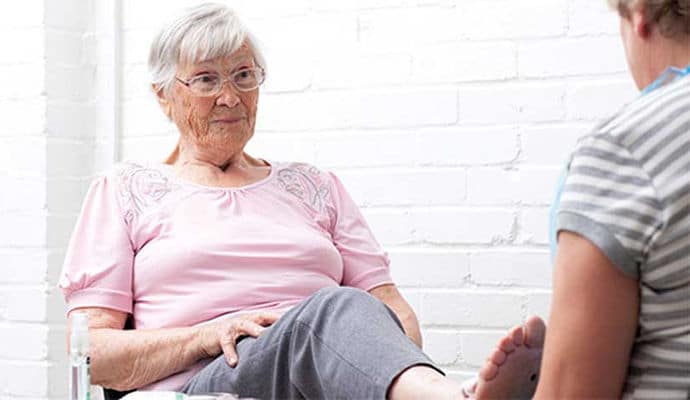
Getting dressed and undressed is an everyday task that’s challenging for many older adults. A variety of health conditions can make independent dressing difficult: Alzheimer’s, dementia, stroke, arthritis, limited mobility, surgery recovery, and others. Alium Adaptive Apparel shares 5 helpful dressing tips that make the process easier and smoother for both seniors and caregivers.
Getting dressed is a daily action that most of us take for granted.
We often don’t think twice about putting our arms up to dive into a sweater or reaching down to tie our shoes.
But in caregiving situations, a person may have lost the ability to dress themselves and may need help. Sometimes, this can cause challenging situations.
Many older adults prefer to be dressed in daytime clothes each day. Being dressed often helps them feel more confident and be more comfortable interacting with others.
But for many caregivers, helping someone dress and undress twice a day can be mentally and physically exhausting.
To help this process run more smoothly, here are 5 top tips for caregivers who are helping an older adult with dressing.
1. Allow extra time for dressing
Allowing plenty of time each day for dressing and undressing helps the process feel more relaxed, calm, and pleasant. That makes it more likely that your older adult will cooperate and help with the process.
Because of common health conditions, it usually takes a lot of extra time to help older adults get dressed.
For example, if your older adult has cognitive impairments like Alzheimer’s or dementia, they may not be able to sequence the steps of getting dressed or understand how a clothing item is worn.
Or if your older adult has lost flexibility, mobility, hand dexterity or is recovering from stroke or surgery, they may need to move slowly through the dressing steps to avoid pain.
2. Give simple choices
No matter a person’s age or cognitive ability, people like to have choice in what they wear.
Providing two or three appropriate, seasonal options help seniors maintain a sense of self and of control through the act of choosing what to wear.
3. Check for skin issues
While you help someone get dressed, it also gives you a chance to check for any skin issues so you can help them stay as healthy and comfortable as possible.
Redness, irritation, and pressure sores can quickly develop in people who have limited mobility or who usually don’t move around much during the day.
Pay particular attention to the buttocks, shoulder blades, elbows, and heels. It’s important to catch skin breakdown early to avoid open wounds and infections.
4. Reduce combative behaviors
When someone has Alzheimer’s or dementia, they may become combative when you try to help them dress or undress.
Sometimes, changing your approach can help. Each person is different, so it’s a good idea to try different approaches or timing to see what works best for them.
Some people may feel more comfortable if they see you approaching and helping with their clothes. If what you’re doing isn’t clearly visible to them, they might feel startled or scared.
But others might feel defensive and get combative if you stand in front of them while helping them with dressing.
If that’s the case, try approaching from the side (out of their direct line of sight) and gently putting your arm around them. This can help them feel less threatened by the dressing process — especially when a calm voice and gentle touch are used.
5. Search the Internet for specialized clothing and dressing tips
Many caregivers aren’t aware of how many resources there are that help with dressing.
Specialized clothing designed for seniors and caregivers is a growing part of the apparel industry — innovative new products are constantly being developed.
Try searching online for “adaptive clothing”, “clothing for dementia” (or another health condition), or “dressing aids” and you’ll likely find a wide variety of products that help with your older adult’s dressing challenges.
Next Step Print or save these 5 top dressing tips in a handy one-page tip sheet from Alium Adaptive Apparel (PDF)
Recommended for you:
- 10 Simple Dressing Aids Help Seniors Stay Independent
- How to Reduce Resistance to Care in Dementia: An Expert Demonstrates [Video]
- Dressing Someone with Alzheimer’s: 9 Expert Tips [Infographic]
Image: Dementia Caring
About the Author

Connie is the founder of DailyCaring.com and was a hands-on caregiver for her grandmother for 20 years. (Grandma made it to 101 years old!) She knows how challenging, overwhelming, and all-consuming caring for an older adult can be. She also understands the importance of support, especially in the form of practical solutions, valuable resources, and self-care tips.













Here is my additional tip: As my mother, who has dementia and is weak, doesn’t like to get dressed, I start by a) giving her a choice of a couple outfits (as noted in the article), then b) have her take off her shirt and rub some high-quality, nice-smelling body cream on her back and arms. Surprisingly, since she usually doesn’t like being touched much, she loves this. From there, it’s a breeze…ALSO: we skip the bras and go for t-shirts under her shirts now….
Excellent tips! Thank you for sharing 💜